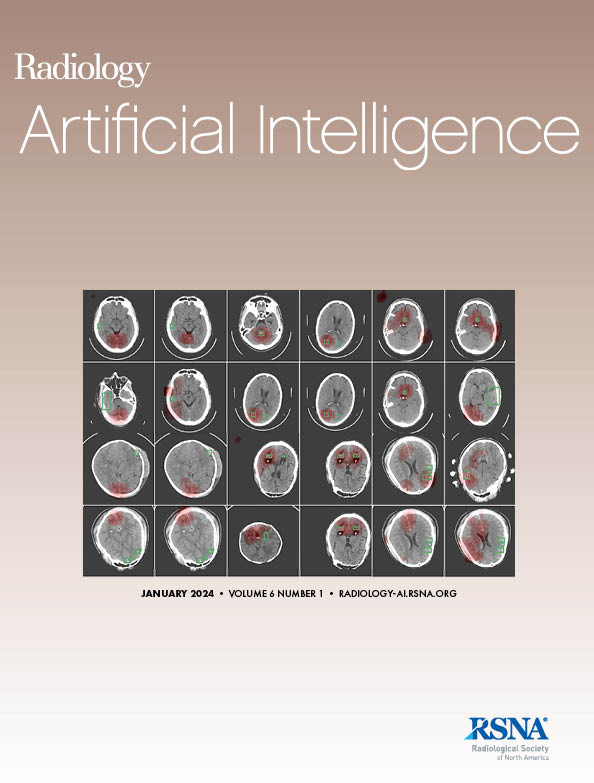Lukas Hirsch, Elizabeth J Sutton, Yu Huang, Beliz Kayis, Mary Hughes, Danny Martinez, Hernan A Makse, Lucas C Parra
下载PDF
{"title":"High-Performance Open-Source AI for Breast Cancer Detection and Localization in MRI.","authors":"Lukas Hirsch, Elizabeth J Sutton, Yu Huang, Beliz Kayis, Mary Hughes, Danny Martinez, Hernan A Makse, Lucas C Parra","doi":"10.1148/ryai.240550","DOIUrl":null,"url":null,"abstract":"<p><p>Purpose To develop and evaluate an open-source deep learning model for detection and localization of breast cancer on MRI scans. Materials and Methods In this retrospective study, a deep learning model for breast cancer detection and localization was trained on the largest breast MRI dataset to date. Data included all breast MRI examinations conducted at a tertiary cancer center in the United States between 2002 and 2019. The model was validated on sagittal MRI scans from the primary site (<i>n</i> = 6615 breasts). Generalizability was assessed by evaluating model performance on axial data from the primary site (<i>n</i> = 7058 breasts) and a second clinical site (<i>n</i> = 1840 breasts). Results The primary site dataset included 30 672 sagittal MRI examinations (52 598 breasts) from 9986 female patients (mean age, 52.1 years ± 11.2 [SD]). The model achieved an area under the receiver operating characteristic curve of 0.95 for detecting cancer in the primary site. At 90% specificity (5717 of 6353), model sensitivity was 83% (217 of 262), which was comparable to historical performance data for radiologists. The model generalized well to axial examinations, achieving an area under the receiver operating characteristic curve of 0.92 on data from the same clinical site and 0.92 on data from a secondary site. The model accurately located the tumor in 88.5% (232 of 262) of sagittal images, 92.8% (272 of 293) of axial images from the primary site, and 87.7% (807 of 920) of secondary site axial images. Conclusion The model demonstrated state-of-the-art performance on breast cancer detection. Code and weights are openly available to stimulate further development and validation. <b>Keywords:</b> Computer-aided Diagnosis (CAD), MRI, Neural Networks, Breast <i>Supplemental material is available for this article.</i> See also commentary by Moassefi and Xiao in this issue. © RSNA, 2025.</p>","PeriodicalId":29787,"journal":{"name":"Radiology-Artificial Intelligence","volume":" ","pages":"e240550"},"PeriodicalIF":13.2000,"publicationDate":"2025-09-01","publicationTypes":"Journal Article","fieldsOfStudy":null,"isOpenAccess":false,"openAccessPdf":"https://www.ncbi.nlm.nih.gov/pmc/articles/PMC12464713/pdf/","citationCount":"0","resultStr":null,"platform":"Semanticscholar","paperid":null,"PeriodicalName":"Radiology-Artificial Intelligence","FirstCategoryId":"1085","ListUrlMain":"https://doi.org/10.1148/ryai.240550","RegionNum":0,"RegionCategory":null,"ArticlePicture":[],"TitleCN":null,"AbstractTextCN":null,"PMCID":null,"EPubDate":"","PubModel":"","JCR":"Q1","JCRName":"COMPUTER SCIENCE, ARTIFICIAL INTELLIGENCE","Score":null,"Total":0}
引用次数: 0
引用
批量引用
Abstract
Purpose To develop and evaluate an open-source deep learning model for detection and localization of breast cancer on MRI scans. Materials and Methods In this retrospective study, a deep learning model for breast cancer detection and localization was trained on the largest breast MRI dataset to date. Data included all breast MRI examinations conducted at a tertiary cancer center in the United States between 2002 and 2019. The model was validated on sagittal MRI scans from the primary site (n = 6615 breasts). Generalizability was assessed by evaluating model performance on axial data from the primary site (n = 7058 breasts) and a second clinical site (n = 1840 breasts). Results The primary site dataset included 30 672 sagittal MRI examinations (52 598 breasts) from 9986 female patients (mean age, 52.1 years ± 11.2 [SD]). The model achieved an area under the receiver operating characteristic curve of 0.95 for detecting cancer in the primary site. At 90% specificity (5717 of 6353), model sensitivity was 83% (217 of 262), which was comparable to historical performance data for radiologists. The model generalized well to axial examinations, achieving an area under the receiver operating characteristic curve of 0.92 on data from the same clinical site and 0.92 on data from a secondary site. The model accurately located the tumor in 88.5% (232 of 262) of sagittal images, 92.8% (272 of 293) of axial images from the primary site, and 87.7% (807 of 920) of secondary site axial images. Conclusion The model demonstrated state-of-the-art performance on breast cancer detection. Code and weights are openly available to stimulate further development and validation. Keywords: Computer-aided Diagnosis (CAD), MRI, Neural Networks, Breast Supplemental material is available for this article. See also commentary by Moassefi and Xiao in this issue. © RSNA, 2025.
用于MRI乳腺癌检测与定位的高性能开源AI。
“刚刚接受”的论文经过了全面的同行评审,并已被接受发表在《放射学:人工智能》杂志上。这篇文章将经过编辑,布局和校样审查,然后在其最终版本出版。请注意,在最终编辑文章的制作过程中,可能会发现可能影响内容的错误。目的开发并评估一种用于乳腺癌MRI检测和定位的开源深度学习模型。在这项回顾性研究中,在迄今为止最大的乳房MRI数据集上训练了一个用于乳腺癌检测和定位的深度学习模型。数据包括2002年至2019年在美国一家三级癌症中心进行的所有乳房核磁共振成像。该模型在原发部位(n = 6,615个乳房)的矢状面mri上得到验证。通过评估模型对原发部位(n = 7058个乳房)和第二个临床部位(n = 1840个乳房)的轴向数据的表现来评估其普遍性。结果原发部位数据包括来自9986例女性患者(平均[SD]年龄,53岁)的30,672次矢状位MRI检查(52,598个乳房)。该模型实现了在原发部位检测癌症的受试者工作特征曲线下面积(AUC)为0.95。特异性为90%(5717/6353),模型敏感性为83%(217/262),与放射科医生的历史表现数据相当。该模型可以很好地推广到轴向检查,同一临床部位的AUC为0.92,次要部位的AUC为0.92。该模型在88.5%(232/262)的矢状位图像、92.8%(272/293)的原发部位轴向图像和87.7%(807/920)的继发部位轴向图像上准确定位肿瘤。结论该模型在乳腺癌检测中具有最先进的性能。代码和权重都是公开的,以刺激进一步的开发和验证。©RSNA, 2025年。
本文章由计算机程序翻译,如有差异,请以英文原文为准。

 求助内容:
求助内容: 应助结果提醒方式:
应助结果提醒方式:


